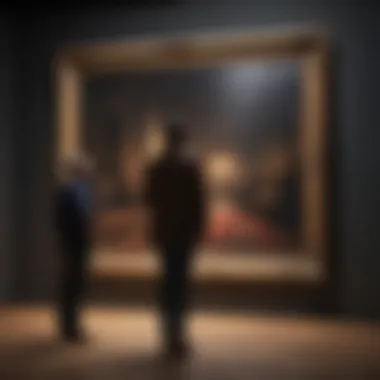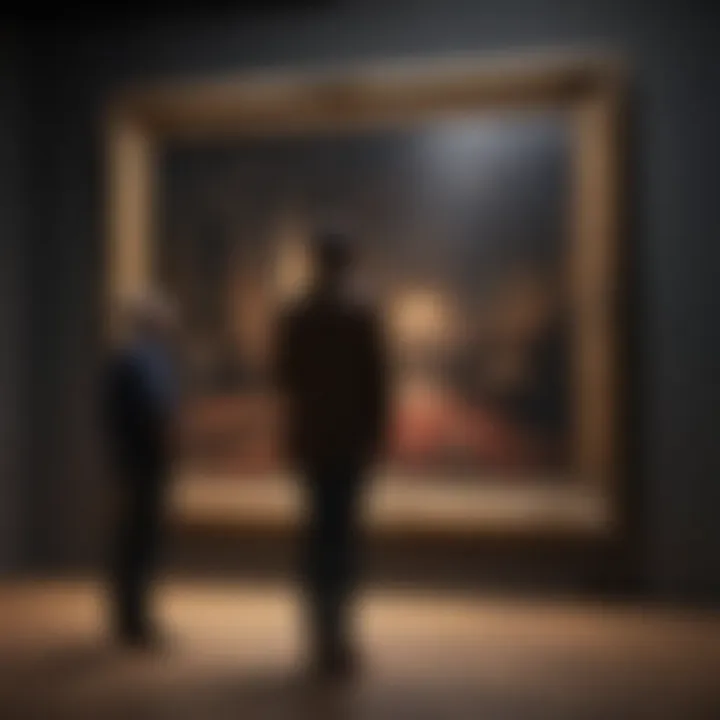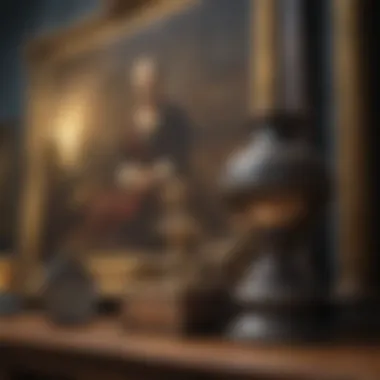Comprehensive Evaluation of Paintings: Methodologies and Perspectives


Intro
Evaluating paintings is a complex task that requires a deep understanding of various factors. This includes the historical context in which the artwork was created, the technical skills of the artist, and the cultural significance that the painting may hold. Each of these elements merges to create a multifaceted approach to assessment.
This article endeavors to explore these diverse perspectives and methodologies, presenting a clear framework for both seasoned critics and those new to art evaluation. The aim is to equip readers with insights into how different factors influence our interpretation of paintings, fostering a greater appreciation of the art form.
Research Context
Background and Rationale
The act of evaluating paintings goes beyond mere aesthetics. Art has always served as a reflection of society, and understanding its layers requires both historical knowledge and critical thinking skills. Many artists create works in response to their environment, societal norms, and personal experiences. Hence, knowing the background of a piece can significantly alter its perceived value and meaning.
Furthermore, the rationale behind painting evaluations encompasses a wide array of educational contexts. Students of art history, practicing artists, critics, and casual observers all exhibit different interests and biases when dissecting a piece of art. Access to frameworks of evaluation enables deeper discussions within academic circles as well as enriches personal engagement with art.
Literature Review
A review of existing literature reveals various methodologies employed in art evaluation. Scholarly articles often focus on critical frameworks, while others emphasize experiential learning or emotional responses to art. Notable texts include:
- Ways of Seeing by John Berger, which questions traditional art interpretation.
- Art as Experience by John Dewey, linking aesthetic experience to social contexts.
- The Shock of the New by Robert Hughes, exploring modern art movements.
Each of these works provides valuable insights that contribute to our understanding of the evolution of painting evaluation. By synthesizing historical perspectives with contemporary analysis, we gain a more profound comprehension of what drives viewers' interpretations.
Methodology
Research Design
This article employs qualitative methodologies to assess and evaluate paintings. By engaging with both theoretical frameworks and practical examples, it aims to distill an accessible approach. The aim is to combine established critiques with personal interpretations, allowing for a holistic understanding of art evaluation.
Data Collection Methods
The data for this exploration is collected through various means:
- Interviews with artists and art critics provide firsthand accounts of evaluation processes.
- Case studies of specific paintings allow for deeper analysis of context and technique.
- Surveys of art students offer insights into how fresh perspectives shape interpretations.
Using these methods presents an inclusive approach to understanding the nuances of art evaluation while addressing individual perceptions and broader cultural implications.
Prelims to Painting Evaluation
Painting evaluation is a pivotal aspect in the field of art criticism and appreciation. It encompasses a structured approach to understand and critique artworks deeply. This evaluation is essential not only for critics and collectors but also for artists and audiences who seek to engage thoughtfully with art. By examining various methodologies and perspectives, the evaluation process encourages a more nuanced appreciation of individual pieces and their broader artistic contexts.
Defining Painting Evaluation
Painting evaluation is the process of assessing and analyzing artworks to determine their significance, quality, and impact. It involves an examination of various elements such as technique, composition, color, and context. Critics and scholars employ distinct criteria depending on their disciplinary perspectives, which can range from historical interpretations to contemporary aesthetic theories. The aim is to provide a clear framework that allows both experts and casual observers to make informed judgments about a particular work of art.
Evaluation can take on different forms. For instance, formal analysis focuses on the visual elements of a painting, while contextual analysis considers external factors such as cultural, political, and social influences surrounding the artwork. This multifaceted approach allows for a more holistic understanding of paintings and how they are perceived within both academic circles and the general public.
Importance of Evaluation in Art Criticism
Art criticism relies heavily on the evaluation of artworks. It serves several purposes that are crucial for furthering appreciation for artistic endeavors. Firstly, painting evaluation helps contextualize art within the larger narrative of history and culture. By understanding where a painting fits in time and space, one gains insight into its intended message or emotional resonance.
Furthermore, evaluation forms the basis for discussions about quality and value in artworks. In a marketplace driven by subjective tastes, establishing standards for evaluation allows collectors, museum curators, and galleries to navigate the art world more effectively. This contributes to setting benchmarks for both emerging and established artists.
Additionally, thorough evaluation encourages dialogue among artists, critics, and audiences. It fosters thought-provoking conversations about artistic choices and societal reflections, enriching the discourse surrounding visual arts. As such, strong evaluation practices contribute to a more vibrant and informed art community.
"Evaluation provides a critical lens through which we can explore the complexities of art and its myriad interpretations."
In summary, the introduction to painting evaluation serves as a foundation for exploring the various methodologies, aesthetic criteria, and societal influences on art assessment. This understanding equips both art lovers and professionals to engage more critically and appreciatively with the visual arts.
Historical Context of Painting Evaluation
Understanding the historical context of painting evaluation is crucial in appreciating how art has been critiqued through various periods. This context not only shapes present methodologies but also influences perceptions of what constitutes value in art. By exploring this background, we can gain insights into the complexities involved in art criticism and how these have evolved over time.
Evolution of Art Criticism
The evolution of art criticism can be traced back to ancient civilizations. In Ancient Greece, philosophers like Plato and Aristotle began discussing the essence of beauty and art. Their ideas laid the groundwork for future critiques. During the Renaissance, artists such as Leonardo da Vinci and Michelangelo not only created masterpieces but also engaged in discussions regarding artistic techniques. This period marked a shift towards more technical evaluations, focusing on mastery of form and perspective.
In the 18th century, the emergence of the Enlightenment brought a new wave of thought. Art criticism became more systematic, with critics like Denis Diderot introducing the idea of reviewing exhibitions. His writings recognized the importance of context, offering insights that resonated with audiences and fellow artists alike.
As we moved into the modern era, especially during the 19th and 20th centuries, art criticism evolved significantly. Movements like Impressionism and Cubism challenged traditional notions of representation. Critics began to explore the emotional and societal implications of art rather than just aesthetic qualities. This shift demanded a broader approach to evaluation, recognizing the cultural narratives behind artworks. Modern art criticism now often embraces a range of perspectives, incorporating psychological and philosophical frameworks alongside technical analysis.
Key Movements Influencing Evaluation Standards
Several key movements have markedly influenced the standards of painting evaluation throughout history.
- Romanticism: This movement emphasized individual expression and emotional depth. Art critics began to value the artist's intention and emotional resonance over purely technical skills.
- Impressionism: With its focus on light and color, Impressionism shifted the criteria for evaluation. Critics now looked at how effectively artists captured fleeting moments rather than adhering to traditional forms.
- Modernism: In the early 20th century, modernist movements challenged conventions. Critics expanded their focus to include conceptual frameworks and social commentary, resulting in a more holistic approach to evaluation.
- Postmodernism: This paradigm questioned the very foundations of artistic value. The subjective nature of interpretation became prominent, leading to the understanding that paintings could have multiple meanings and significance depending on cultural and societal contexts.
In summary, the historical context of painting evaluation reveals a complex interplay between technical skill, emotional expression, and cultural narratives. This evolution has established a diverse framework within which paintings are assessed today.
"Art criticism has transformed from a purely technical evaluation to a multifaceted discourse incorporating emotional, cultural, and social dimensions."


The recognition of historical movements illustrates how art evaluation is not static; it adapts to changes in societal values and artistic intentions. Thus, understanding these shifts enriches our approach to painting evaluation, providing a deeper appreciation for the artworks themselves.
Key Methodologies in Painting Evaluation
In understanding the evaluation of paintings, it is crucial to consider the methodologies employed by critics and art scholars. These methodologies serve as tools that help unpack layers of meaning and technical prowess within artworks. Key methodologies allow for structured analysis, enhancing the critique's depth and ensuring that a work is appreciated not only for its visual appeal but also for its deeper significance.
Each methodology, whether it focuses on form, context, or comparison, provides insights that resonate with different aspects of art and its place in society. By exploring these methodologies, evaluators can aptly navigate the complexity of artistic expression and address the nuances that define a painting's value.
Formal Analysis
Formal analysis is a cornerstone of painting evaluation. This method emphasizes the visual elements of a work, such as color, line, shape, texture, and composition. By dissecting these components, one gains a clearer understanding of the artist's intentions and technical choices.
During formal analysis, evaluators often assess how these elements interact to create harmony or discord within a piece. Critics might raise questions like:
- How does the color palette contribute to mood?
- What effect does the composition have on movement within the painting?
- Are there patterns or repetitions in line that evoke a particular feeling?
This approach enhances appreciation for the craft behind a painting. It allows for a focused critique, grounded in observable characteristics that many viewers may overlook. Formal analysis provides a baseline for further exploration into contextual or comparative methodologies.
Contextual Analysis
Contextual analysis shifts the focus from the painting��’s formal qualities to the broader circumstances surrounding its creation. This methodology considers the historical, cultural, and social influences that may have shaped the artwork. It can encompass various elements, such as:
- The artist's background and experiences
- The socio-political climate during the time of creation
- Artistic movements or trends that may have influenced the work
Understanding a painting in context allows for a richer interpretation. For instance, knowing that an artwork was created during a time of upheaval may change how one perceives its themes. Contextual analysis can reveal hidden messages or intentions that a purely formal analysis might miss.
Comparative Analysis
Comparative analysis involves examining a painting alongside other works, whether by the same artist or across different artists and time periods. This methodology is invaluable for highlighting similarities and differences in style, technique, and thematic exploration.
By comparing artworks, evaluators can:
- Identify key influences between pieces.
- Trace the evolution of an artist’s style over time.
- Explore how different cultures address similar themes.
This approach not only enhances understanding of individual works but also situates them within a larger artistic dialogue. Comparative analysis can challenge or reinforce the conventional narratives about certain artists or movements, enriching one's overall grasp of art history.
"Art evaluation is not merely an exercise in judgment; it is an exploration of the interconnectedness of ideas, culture, and expression."
Through these methodologies, one can develop a multi-faceted understanding of paintings. Each method connects to the others, creating a holistic framework for evaluation that benefits students, researchers, educators, and professionals alike.
Aesthetic Criteria in Evaluation
Understanding aesthetic criteria is crucial in the practice of painting evaluation. These criteria serve as the framework through which art is interpreted and judged. Evaluating aesthetic value involves considering several elements like composition, color harmony, and overall emotional impact. Each of these aspects plays a significant role in how a painting resonates with its viewers.
Understanding Aesthetic Value
Aesthetic value refers to the qualities in artwork that evoke feelings or thoughts. Critics often assess aesthetics through a conceptual lens, examining how elements such as proportion, balance, and rhythm contribute to the artwork's perception.
- Composition: The arrangement of visual elements can determine how the viewer's eye moves across the canvas. A well-balanced composition might draw focus, creating a sense of harmony in the work.
- Color Harmony: Color choices significantly influence mood and narrative. Warm tones may evoke comfort or passion, while cool tones can invoke calmness or sadness. Understanding these implications is vital in evaluating a painting's aesthetic impact.
- Artistic Style: The unique style of the painter can affect aesthetic value. Different styles, such as impressionism or abstract expressionism, present unique methods of expression that warrant different evaluative approaches.
By recognizing these components, critics and viewers alike can engage more thoroughly with a painting beyond surface impressions.
Emotional and Intellectual Responses
Art evokes a range of emotional and intellectual responses, which are pivotal to its evaluation. Each viewer's reaction is influenced by personal backgrounds, experiences, and cultural contexts.
- Emotional Resonance: A painting might elicit joy, sadness, or nostalgia. Evaluators must note how successfully the artwork communicates these emotions. Strong emotional connections can elevate a work's value significantly.
- Cognitive Engagement: Beyond emotions, an artwork may encourage critical thinking or reflection. Viewers may analyze symbolism, themes, or techniques, engaging with deeper meanings behind the brushstrokes.
- Cultural Influences: The societal context surrounding a painting also shapes audience interpretations. Factors such as historical events or cultural movements may inform emotional responses as well, directing the viewer’s understanding of the artwork.
The interplay between emotional and intellectual responses creates a dynamic atmosphere in art evaluation. A deeper understanding of these responses enriches the critical analysis of paintings, ultimately enhancing their appreciation and significance.
"The true measure of a painting is not how it is seen at first glance, but the layers of meaning and emotion it reveals over time."
As evaluators navigate these aesthetic criteria, they gain insights that foster a richer dialogue surrounding paintings, both in academic contexts and public discourse.
Technical Aspects of Painting Evaluation
The technical aspects of painting evaluation serve as a critical foundation for understanding artworks. Evaluating these elements helps not only to appreciate the aesthetic qualities of a painting but also to understand the artist's intentions and the historical context in which the work was created. By dissecting materials and techniques, critics and scholars can gain insights that often remain hidden behind layers of paint. This examination can reveal the artist's skill level, their choice of medium, and the methods they employed, which in turn contributes to the artwork's overall significance.
Material and Technique Analysis
Material and technique analysis involves scrutinizing the substances used in the creation of a painting, as well as the methods applied by the artist. This analysis is essential for several reasons. First, it provides valuable information about the durability and longevity of the artwork. For instance, oil paints used on canvas behave differently over time compared to watercolor on paper.
Second, understanding the materials can give context regarding the period in which the painting was made. Artists often had limited access to certain materials, which sometimes influenced their choices and the overall style of their artwork. Analyzing materials could highlight unique characteristics, such as the use of natural pigments vs. synthetic dyes.
- Considerations in Material Analysis:
- The source of materials.
- The compatibility of various substances used.
- How materials can affect color vibrancy over time.
Artists' techniques also vary widely, and a detailed analysis may reveal their methods. For example, a layering technique could indicate careful planning and precision, while an expressionist approach might show spontaneous application. This insight helps in understanding the artwork and enables researchers to classify it within particular art movements. An artist who frequently uses glazing techniques, for example, may connect to the tradition of the Old Masters.
Brushwork and Texture Examination


Examining brushwork and texture is another vital aspect of painting evaluation. Brushwork can convey an artist's emotional state, stylistic preferences, and technical capabilities. The physical texture of a painting adds another layer of meaning, often influencing how light interacts with the surface. This creates varying visual effects that can change dramatically when viewed under different conditions.
- Key Aspects of Brushwork Examination:
- Type of brushstroke: Is it fine, bold, or textured?
- Stroke direction: What does the flow of the brushwork indicate?
- Layering: How many layers did the artist use?
Textures can evoke feelings and memories, making them crucial in art interpretation. Artists can achieve texture through various means—thick paint application (impasto), rough surfaces, or delicate washes. Each approach imparts unique qualities to a painting, contributing to its impact.
Art critics often look for how texture and brushwork work in tandem to challenge or reinforce a painting's message. A rough and chaotic texture may evoke a sense of turmoil, while smooth and blended areas might communicate tranquility. Thus, brushwork and texture are not just characteristics of style; they are intentional tools used by artists to elicit specific emotional responses from viewers.
"The paints and brushes artists choose are a direct reflection of their creative intentions and conceptual frameworks. Understanding these elements deepens the appreciation of the artistry involved."
By systematically addressing technical components, painting evaluation transcends mere aesthetic appreciation. It establishes a systematic understanding of the craft involved, providing a lucid pathway to engaging with art deeply.
Cultural and Societal Influences
Understanding the cultural and societal influences on painting evaluation is crucial for a thorough comprehension of how artworks are perceived and assessed. Cultural context refers to the values, beliefs, and traditions that define a particular society at a given time. These influences shape both the creation of artworks and the interpretations they receive. Societal factors, including historical events, social movements, and the demographic makeup of communities, also inform how paintings are evaluated. An artwork will often reflect the zeitgeist of its time, offering insight into the social conditions surrounding its creation.
Cultural Context of Artworks
The cultural setting in which a painting is produced plays a significant role in its evaluation. For instance, artworks from the Renaissance are often viewed through the lens of the humanism movement that characterized the period. This context heightens appreciation of the emphasis on individualism and naturalism in these paintings. An evaluator often considers how historical and cultural narratives influence the subject matter, technique, and intentions of the artist. Today, post-colonial perspectives offer a re-evaluation of artworks from formerly colonized cultures, emphasizing Indigenous narratives and critiques of colonialism.
Factors to examine in cultural context include:
- Historical Events: Wars, revolutions, and significant societal changes shape artistic expression.
- Cultural Movements: The influence of movements such as Modernism or Surrealism can affect how paintings are created and evaluated.
- Geographical Influence: Local traditions, materials available, and regional issues significantly impact both content and reception.
In considering cultural context, it becomes necessary to explore how these factors can alter evaluations. An artwork initially celebrated may face scrutiny as cultural perspectives shift over time, revealing biases in the original interpretation.
Social Significance of Paintings
The social relevance of paintings often transcends their aesthetic value. Paintings capture the essence of societal conditions and contribute to conversations around identity, power, and resistance. Important themes such as race, gender, and class can be embedded in artwork, reflecting the struggles and triumphs of various groups. This becomes especially relevant in contemporary evaluations where diversity and representation are critical.
Evaluations that address social significance also tap into:
- Civic Engagement: Art can elicit public response and activism, making it vital for understanding societal impacts.
- Community Identity: Local artists often depict the narratives of their communities, showcasing the struggles and aspirations of their peers.
- Historical Reflection: Paintings can serve as documents, portraying historical injustices or triumphs, thus serving as a tool for reflection and education.
"Art is not freedom from discipline, but disciplined freedom."
- John F. Kennedy
In this light, evaluating paintings demands more than a focus on technique and aesthetics. It necessitates grappling with the artwork's potential to communicate broader social messages.
In summary, cultural and societal influences remain integral to painting evaluation. Recognizing and understanding these elements enhances the depth of appreciation for any artwork, making the evaluation process richer and more conducive to informed discussions.
The Role of Art Institutions
Art institutions play a significant role in the evaluation of paintings. They are the platforms where artworks are exhibited, critiqued, and analyzed. These institutions contribute to the discourse surrounding art by shaping the context within which paintings are appreciated and understood. Their influence can be seen in how they curate exhibitions and select pieces for representation.
Art Galleries and Museums
Art galleries and museums serve as vital hubs for the dissemination and evaluation of paintings. These institutions provide artists with visibility and legitimacy. They create opportunities for dialogue about art through exhibitions that showcase diverse perspectives.
In galleries, artworks are often displayed within specific themes or styles, inviting viewers to engage with them in a curated context. This curatorial practice guides interpretation and can influence critical reception. For example, a contemporary art gallery may exhibit work that engages with current social issues, thus prompting discussions regarding the relevance of these artworks in today’s society.
Museums, on the other hand, often hold collections that span various periods and styles. This diversity allows for a broader understanding of art history and its evolution. Museums may conduct in-depth studies and publish catalogs that provide critical assessments of their collections. These publications are invaluable resources for researchers and students alike.
Art institutions also facilitate educational programs and workshops. They promote appreciation for both traditional and contemporary forms of painting. By fostering learning opportunities, museums and galleries help build critical skills in painting evaluation. This, in turn, nurtures a more informed audience, which is essential for a vibrant art community.
Contemporary Art Fairs
Contemporary art fairs have gained prominence in recent years. They represent a convergence of galleries, collectors, and artists under one venue. These fairs have become influential in shaping trends in the art world.
At art fairs, various artworks are presented side by side, allowing for instant comparison and evaluation. This setting can affect how paintings are perceived, as they often reveal artistic trends and market demands. For example, a particular color palette or style may emerge as prominent based on the works displayed.
Moreover, contemporary art fairs create networks of relationships among stakeholders. They connect artists with potential buyers and critics, fostering an environment for discussion and collaboration. These interactions can lead to critical exposure for emerging artists, impacting their careers significantly.
As these institutions evolve, they reflect the changing dynamics of art evaluation, shaped by societal influences and technological advancements. The role of art institutions, thus, is integral to understanding how paintings are evaluated and appreciated across different contexts.
Subjectivity in Painting Evaluation
Subjectivity is a fundamental aspect of painting evaluation, shaping the way art is perceived and critiqued. The subjective nature of art means that each viewer brings unique personal experiences, cultural backgrounds, and emotional responses to their interpretation of a painting. This intrinsic characteristic is vital for understanding the diverse perspectives that influence art appreciation and criticism.
Art's subjective facet allows for a rich tapestry of interpretations. For instance, a single painting can elicit varied emotional reactions depending on the viewer's circumstances, memories, and knowledge. This individuality enhances the dialogue around artworks, encouraging wider discourse and deeper engagement with the piece. The subjectivity also challenges the notion of a singular 'correct' evaluation, highlighting that multiple viewpoints can coexist and enrich the understanding of art.
On the other hand, the subjective evaluation of paintings presents several considerations. Critics and scholars must navigate their biases while assessing artworks, striving for objectivity even as they acknowledge their personal views. This balancing act can lead to conflicts, especially when an individual interpretation starkly contrasts with established critical consensus. Recognizing the influence of subjectivity can enhance the appraisal process, allowing a more nuanced understanding of both the artwork and its audience.
"Art is not what you see, but what you make others see." - Edgar Degas
Factors influencing individual interpretation are numerous. Cultural background significantly impacts how art is perceived. For example, a viewer from a Western cultural context may have a different understanding of symbolism compared to someone from an Indigenous background. Personal experiences often dictate the emotional resonance of a piece as well. An artwork depicting loneliness may strike a nerve for someone who has experienced isolation, while another viewer might see it as merely a representation of an artistic concept without any personal connection.
In summary, subjectivity in painting evaluation enriches art criticism and appreciation. However, it also necessitates careful consideration of individual biases and context. This section sets the stage for discussing more specific elements of subjectivity within painting evaluation, particularly individual interpretation and the tension between critical consensus and personal opinions.


Individual Interpretation
Individual interpretation plays a crucial role in the subjective evaluation of paintings. Each person approaches art with distinct influences, ranging from cultural context to personal experiences. This phenomenon underscores that an artwork does not exist in a vacuum; it interacts dynamically with the viewer's mind.
When viewers encounter a painting, they project their stories onto the canvas. For instance, a piece depicting a serene nature scene can evoke feelings of peace in one viewer while reminding another of a lost loved one. This personal connection can significantly enhance the appreciation and depth of understanding of the artwork, transforming it from mere visual consumption into a lived experience.
Readers may also notice how the various elements within a painting impact individual interpretation. The color palette, composition, and subject matter can all evoke different emotions and reactions. A vibrant color scheme may create an uplifting mood, while muted tones might suggest melancholy. Thus, the viewer's engagement with these components contributes to a mixture of interpretations that can vary widely across the audience.
Critical Consensus vs. Personal Opinions
The tension between critical consensus and personal opinions is an area rich with complexities. In art criticism, a body of experts may reach a consensus based on shared values and experiences. This collective evaluation can significantly influence how paintings are perceived in the art world. However, personal opinions often diverge from critical consensus, raising questions about the validity and authority of established viewpoints.
While critical opinions aim to provide an objective measure of an artwork's value, they can sometimes overlook individual experiences and cultural influences. This can lead to frustration among viewers who may feel marginalized in their interpretations. Conversely, personal opinions are often viewed as anecdotal and can be challenged within academic circles.
In navigating this tension, it is essential to recognize both perspectives. Critical consensus can serve as a foundational guide for evaluating art but must remain open to personal insights that enrich the overall discourse. The interplay between these elements not only highlights the dynamic nature of painting evaluation but also reinforces the understanding that art is ultimately a subjective experience.
Technological Advances and Their Impact
Technological advancements continue to reshape how we evaluate and interact with paintings. These advancements not only broaden access to art but also create new platforms for engagement and assessment. Evaluating contemporary art now requires understanding these innovations. They provide new tools for experts and amateurs alike. In this section, we will explore the implications of digital art and online platforms for art evaluation.
Digital Art and Evaluation
Digital art has gained traction over the past few decades. It presents unique challenges and opportunities for evaluation. Unlike traditional paintings, digital artworks often exist in a fluid state. They can be endlessly modified or reproduced, complicating the evaluation process.
Evaluating digital art necessitates different criteria. Key aspects include:
- Originality: How does the digital piece stand apart in a world of easy replication?
- Interactivity: Does the art engage the viewer in a unique way?
- Technical Proficiency: What level of skill is evident in the use of digital tools?
Art critics must adapt their methodologies to encompass these factors. This evolution in evaluation methods reflects the changing landscape of creativity. Additionally, with the rise of algorithms in creating art, questions about authorship and creativity become paramount. Evaluators are tasked with searching for the artistic intent behind a piece, regardless of its medium.
Online Platforms for Art Evaluation
The digital era has democratized art evaluation. Many online platforms allow for a broader conversation about art. Websites such as social media networks and dedicated art platforms provide spaces for critique and discussion. These spaces are vital for the dissemination of diverse perspectives on artworks.
Key features of online art platforms include:
- Accessibility: Artists and critics can share works with global audiences.
- Feedback Mechanisms: Viewers can comment and provide instant feedback, fostering engagement.
- Curatorial Voices: Many platforms showcase curator-selected pieces, influencing public perception.
The evolution of these platforms challenges traditional gatekeepers of art. It creates spaces where questions of taste and value are continuously negotiated.
While online platforms promote inclusivity, they also raise concerns. The presence of echo chambers can limit exposure to diverse opinions. Critics must navigate these challenges while remaining open to differing interpretations and insights, emphasizing the ongoing need for thoughtful analysis in art evaluation.
Evaluating Contemporary Art Trends
Evaluating contemporary art trends is essential in understanding the dynamic landscape of the art world today. This section focuses on the factors that shape how paintings are perceived and assessed. It sheds light on the emergence of new genres and significant shifts in audience engagement, providing crucial insights into current artistic practices and the evolving criteria for evaluation.
Emergence of New Genres
The contemporary art scene witnesses a constant expansion of genres. Artists experiment with fresh ideas and mediums, leading to the creation of innovative styles that challenge traditional notions of painting. For instance, digital painting, installation art, and mixed media have gained prominence. These new genres not only provide artists with diverse tools for expression but also challenge audiences to rethink their definitions of painting.
- Key Aspects of New Genres:
- Diversity of Mediums: Artists are moving beyond oil and acrylics to incorporate digital technologies, textiles, and found objects.
- Cross-Disciplinary Approaches: Collaboration among artists across different disciplines blurs the lines between genres.
- Cultural Influences: Global artistic influences are more accessible than ever, contributing to new genres.
Evaluating these new genres requires critics to adopt flexible methodologies. They must consider the context and intent behind each work. A painting that incorporates elements of performance or interactive technology, for example, may necessitate different criteria than a more traditional canvas work.
Shifts in Audience Engagement
The relationship between art and its audience has evolved significantly in contemporary settings. Artworks are now viewed not just as isolated creations but as part of a broader social discourse. Audiences are more actively involved in evaluating and interpreting art, often through means that leverage technology and social media. This shift results in several notable trends:
- Increased Accessibility: Online platforms allow more people to access and engage with art—this democratizes the conversation.
- Community Engagement: Many artists are focusing on social themes, prompting viewers to participate and provide feedback.
- Global Perspectives: The internet facilitates dialogue among diverse audiences, fostering multiple interpretations of a single artwork.
"The emergence of interactive and participatory art has transformed how audiences perceive and evaluate art, leading to diverse interpretations and heightened engagement."
The Future of Painting Evaluation
The exploration of the future of painting evaluation is crucial in understanding how art is appreciated, critiqued, and interpreted in an ever-evolving cultural landscape. With shifts in technology, societal norms, and artistic expression, the methodologies employed to assess paintings must adapt to these changes. Art critics, historians, and educators are increasingly challenged to incorporate new perspectives and frameworks that reflect contemporary values and innovations.
One significant aspect of this future evaluation is the increasing integration of technology. Digital tools and platforms are reshaping access to art, enabling broader engagement and participation. This democratization of art appreciation fosters new ways of interpretation, allowing audiences beyond traditional stakeholders, such as galleries and critics, to contribute insights and critiques. Furthermore, the interaction between artificial intelligence and art evaluation is emerging, leading to innovative ways to analyze compositions based on data-driven metrics. These technological advancements not only enrich the evaluation process but also provoke discussions on authenticity and artistry in the digital realm.
Evolving Standards in Art Criticism
As we look towards the future of art criticism, we observe that standards for evaluating paintings are shifting. The past few decades have witnessed a reassessment of criteria that were once considered rigid. Contemporary art's dynamic nature demands flexibility and inclusivity in evaluation. Criticism is not just about technique and aesthetics anymore; it also encapsulates cultural significance and the intent behind the artwork.
Critics now emphasize a more comprehensive approach that considers:
- The social and political context of the artwork.
- The artist's biography and how their personal experiences influence the piece.
- Audience perceptions and emotional responses.
These evolving standards promote a more holistic understanding of art. They encourage discussions that transcend mere preferences, allowing for a multitude of interpretations that enrich the dialogue surrounding art.
Epilogue
The conclusion of this article serves as a pivotal moment of reflection regarding the multifaceted process of painting evaluation. In a landscape where art interpretation continuously evolves, it is essential to underscore the significance of a structured evaluative approach. Each methodology discussed throughout the text enriches the understanding of how paintings resonate within cultural, historical, and socioeconomic contexts. By synthesizing these methodologies and perspectives, readers can appreciate the depth of art evaluation, whether they engage as practitioners, critics, or audiences.
Summation of Key Points
- Understanding Methodologies: The article illustrates several methodologies integral to painting evaluation, including formal analysis, contextual analysis, and comparative analysis. These methods help to dissect visual language and contextual meanings embedded within artworks.
- Aesthetic Considerations: A pivotal part of the evaluation process lies within aesthetic criteria. Understanding the emotional and intellectual responses garnered by a painting can provide profound insights into its significance and appeal.
- Technical Analysis: The discussions of material choices and technical execution further highlight an artist's intent and craftsmanship, offering layers of appreciation.
- Cultural and Societal Contexts: The exploration of cultural and societal influences emphasizes the importance of context in evaluating a painting, reinforcing how these elements can shape art movements and audience perceptions.
- Subjectivity and Interpretation: The subjective nature of interpretation is acknowledged throughout the article. Observers bring their perspectives, making personal experience an integral part of the evaluation process.
- Technological Influences: The impact of digital advancements and online platforms illustrates how modern technology transforms traditional evaluation methods and encourages democratization in art critique.



